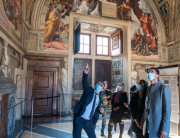The city of Rome is made up of various neighbourhoods/districts that each have their own sentiments and atmospheres. Twice a month, Enjoy Rome will be exploring these neighbourhoods and providing you with our tips to make the most out of your visit. This week we are exploring the Navona neighbourhood; one of Rome’s most historic areas. Book your spot on our guided tour of Ancient Rome to learn more!
The area surrounding Piazza Navona is commonly referred to as the Navona neighbourhood, but it is technically part of the Parione district. Parione is the 6th district (or rione) of Rome and refers to much of the historic centre. The large neighbourhood was actually split into two sections when Corso Vittorio Emmanuele was constructed in the late 19th century – a northern section surrounding Piazza Navona and a southern section surrounding Campo de’ Fiori. If you want to read more about Campo de’ Fiori, check out last week’s Mercato Monday post.
Here are our Navona highlights, as well as recommedations of what to see/do before or after your Ancient tour:
TO SEE:
No visit to to this area is complete without going to the piazza that is at the heart of the district – Piazza Navona. The piazza was actually built on top of Domitian’s stadium from Ancient times! Although you can no longer visit the stadium itself, it is fascinating to imagine while standing amongst the Baroque palazzi, ornate fountains, and colourful street art that has come to define the square. Piazza Navona is the final stop on our Ancient tour.
At the centre of the square is one of Bernini’s most famous masterpieces, the Fountain of Four Rivers, that is said to personify the four major rivers – Nile, Ganges, Danube, and Plate).
Also located inside the square is Chiesa Sant’Agnese in Agone. The baroque-style church was built in the 17th century on the site where Saint Agnes was said to be martyred. Just next to the church you will also find Palazzo Pamphilj. The palace was built by Pope Innocent X, but today is houses the Brazilian embassy.
Find interest in the supernatural? Piazza Navona is actually said to be haunted! Legend has it that the ghost of Costanza Conti de Cupis (a noblewoman from the 1600s) can be seen in the windows looking down on the piazza, but only when there is a full moon.
Just outside Piazza Navona you can also find Museo di Roma – which was founded during the fascist era in order to preserve “old Rome”. Today, it is largely a museum of art that is part of Rome’s network of civic museums.
Not far from Piazza Navona you will find Piazza Pasquino. The piazza itself has a lot to offer including a beautiful church and great restaurants. However, the most interesting part of this small piazza is is the statue that is referred to as one of Rome’s “talking statues”. The statues have been used for centuries as a means for political expression and anonymous civil disobediance. Even today you can see poetry and other forms of political commentary posted next to the statue.
Chiesa Nuova (also known as Chiesa Santa Maria in Valicella) is located just a short walk from the Piazza along Corso Vittorio Emmanuele and features incredible frescos. It was built in 1577 and also has an impressive library inside.
TO WALK:
Via Governo Vecchio is one of the areas main streets. Grab a gelato and to admire the cobblestone streets, boutique shops, and renaissance era homes. Via Coronari and Via della Pace are also worth a stroll.
TO SHOP:
Piazza Navona has no shortage of places nearby to sharp, but the most noteworthy are the vintage and leather shops along Via Governo Vecchio. During the day (as well as sometimes at night) you can also find a variety of artists and craft vendors in the actual piazza, as well as the surrounding area.
TO EAT:
The Navona neighbourhood has a ton to offer in terms of restaurants and the winding streets are home to many authentic italian restaurants. Cul de Sac in Piazza Pasquino offers a large selection of wine and locally curated meat/cheese plates. Pizzeria Baffetto is the place to go for pizza and eating in this family-run establishment is an experience in and of itself. On the other side of Piazza Navona you can also find The Old Bear, whose pasta menu changes daily to ensure the freshest ingrediants.
TO DRINK:
In addition to everything else it has to offer, this neighbourhood is also known for its nightlife. Whether inside the piazza itself or on one of the many sidestreets, there are a variety of places to get a quality cocktail and people-watch. We recommend Bar del Fico; they have an artisanal cocktail menu, aperitivo and even live music. Mimi & Coco and Il Piccolo offer the perfect people-watching locations. If you are looking for your sports fix, Via Governo Vecchio is also home to an Irish pub called The Abbey.
Want to learn more about this historic neighbourhood? Book your tour of Ancient Rome and experience it with a live guide!
What’s your favourite part about the Navona neighbourhood? Let us know in the comments!

















Recent Comments